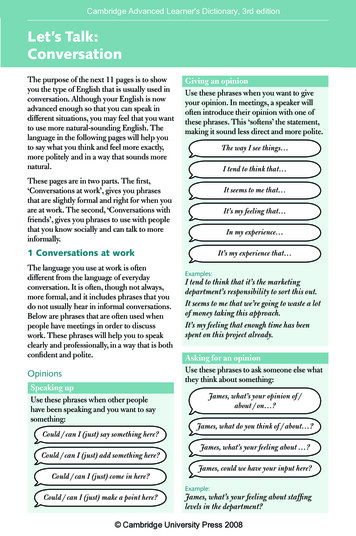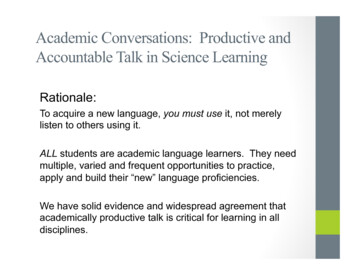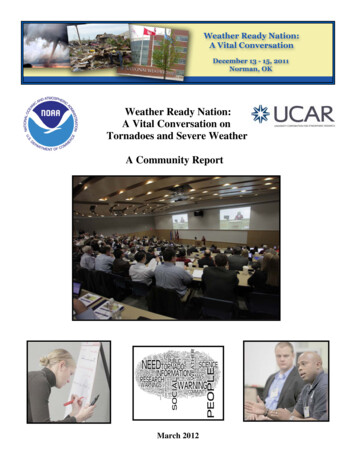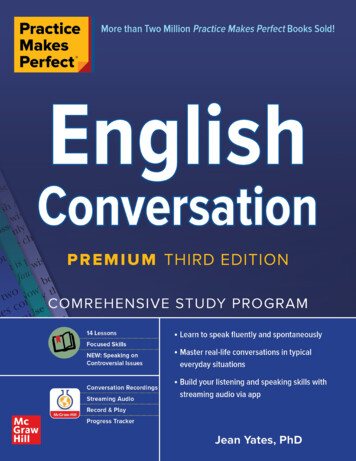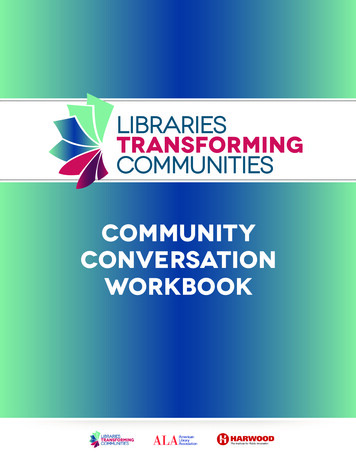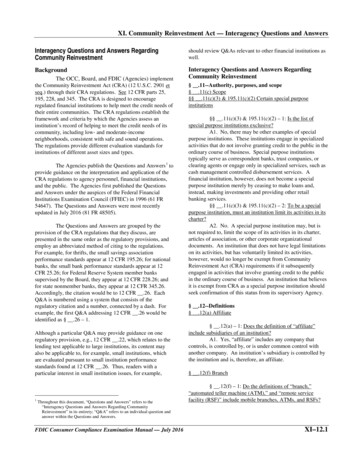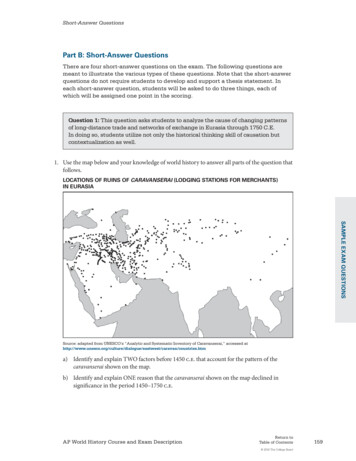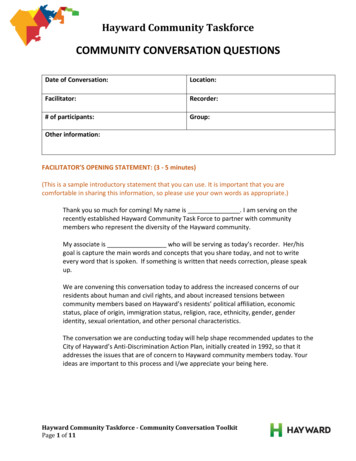
Transcription
Hayward Community TaskforceCOMMUNITY CONVERSATION QUESTIONSDate of Conversation:Location:Facilitator:Recorder:# of participants:Group:Other information:FACILITATOR’S OPENING STATEMENT: (3 - 5 minutes)(This is a sample introductory statement that you can use. It is important that you arecomfortable in sharing this information, so please use your own words as appropriate.)Thank you so much for coming! My name is . I am serving on therecently established Hayward Community Task Force to partner with communitymembers who represent the diversity of the Hayward community.My associate is who will be serving as today’s recorder. Her/hisgoal is capture the main words and concepts that you share today, and not to writeevery word that is spoken. If something is written that needs correction, please speakup.We are convening this conversation today to address the increased concerns of ourresidents about human and civil rights, and about increased tensions betweencommunity members based on Hayward’s residents’ political affiliation, economicstatus, place of origin, immigration status, religion, race, ethnicity, gender, genderidentity, sexual orientation, and other personal characteristics.The conversation we are conducting today will help shape recommended updates to theCity of Hayward’s Anti-Discrimination Action Plan, initially created in 1992, so that itaddresses the issues that are of concern to Hayward community members today. Yourideas are important to this process and I/we appreciate your being here.Hayward Community Taskforce - Community Conversation ToolkitPage 1 of 11
Hayward Community TaskforceSample Introduction / Ice-breaker questions: (4 - 10 minutes)A. If group participants know each other already, ask the group: What motivated you to cometo this meeting today?B. If group participants do not know each other: Please pair up with someone you don’t know.Interview each other for 2 minutes to learn more about one another and your motivation forcoming to this meeting. In 4 minutes, we will come back together and ask you to introduceyour partner to the group.Note: If your group is very large, the paired conversations are sufficient ice breakerswithout everyone reporting out after 4 minutes. You can ask a few people to share ifthey have a compelling interest they want to share.C. If a one-to-one conversation, ask: What motivated you to participate in this conversation?Hayward Community Taskforce - Community Conversation ToolkitPage 2 of 11
Hayward Community TaskforceGROUND RULE SETTING: (3 - 10 minutes)FACILITATOR’S OPENING REMARKS: When we discuss topics like discrimination, people mayhave strong feelings and can be very passionate. We want to have a respectful and productiveconversation, and so it is important that we agree on the ground rules for today’s conversation.We are providing some rules that were previously recommended by similar groups. What dothese rules mean to you? What else would you like to add?FACILITATOR NOTE: If time is short, come with prepared ground rules already written on aflip chart paper, review them, and ask if there are changes or additions that the group wouldlike to make.You can share some or all the following examples, if needed: Listen deeply; Try on new ideas and perspectives; Be respectful; Talk one at a time; Everyone has an opportunity to speak; Speak from an “I” perspective; Speak about your experience; All views are welcomed; Stick to the issue; Personal stories stay in the group unless someone agrees to share their own storyoutside of the group; “Step up, Step back”RECORDER’S NOTE: On a large paper, write Discussion Ground Rules at the top, and recordall the ground rules shared by the group participant’s.After the list is complete, ask the group to confirm that they agree to adhere the Ground Rules.QUESTIONS: (17 – 55 minutes)FACILITATOR REMARKS: We have eight questions for you today, which cover 1) attitudes andbehaviors, 2) equitable access to goods and services, 3) education discrimination,4) employment discrimination, 5) housing discrimination, 6) hate crimes and violence,7) community and police relations, and 8) current social issues. Your answers today will help theTaskforce Members update each section of the Anti-Discrimination Action Plan (ADAP forshort).Hayward Community Taskforce - Community Conversation ToolkitPage 3 of 11
Hayward Community TaskforceQUESTION 1 : ATTITUDES AND BEHAVIORSOPTIONAL INTRO (If there is time and it makes sense for your group):I am going to read the current ADAP language on this topic. Given that the ADAP plan was created in1992, we welcome feedback on the content and language of each of the sections to ensure that weare as inclusive as possible.SECTION II C: Addressing Discriminatory Attitudes and Behaviors: While it is not possible to legislateattitudes and behaviors that build community in Hayward, there are actions that can be taken toimprove relationships between people of differing backgrounds.Hayward takes pride in and celebrates being the third most diverse community in California.A. How would you describe your day-to-day experience in Hayward interacting with people fromdifferent backgrounds, cultures, and identities? How does this impact you?B. What ideas do you have for increasing trust, understanding, and respect across differentgroups in Hayward?C. Who do you trust to help address any social challenges we face as a community? Who needsto be at the table?D. Would you attend community forums to learn about cultures, religions, etc. that are differentfrom your own? If so, what areas interest you?Hayward Community Taskforce - Community Conversation ToolkitPage 4 of 11
Hayward Community TaskforceQUESTION 2: ACCESS TO GOODS AND SERVICESThere are situations where there may be barriers for an individual to access goods, services, oropportunities based on their language, culture, religion, disability status, or other personalcharacteristics.OPTIONAL INTRO (If there is time and it makes sense for your group):I’m going to read the current ADAP language on this topic. We welcome feedback on this language.SECTION II B: Equitable Access: The Americans with Disabilities Act (ADA) is a federal civil rights lawthat requires that in specified circumstances reasonable accommodations be made for persons livingwith disabilities so that they have access to the same opportunities as those without a disability.There are other situations where there may be barriers to equitable access to goods, services, oropportunities based on a person’s language, culture, religion, or other personal characteristics whichare not currently addressed by law.A. Have you or someone you know ever experienced inequitable access in Hayward? If you arecomfortable, would you describe that experience? How did you feel about this then? How doyou feel about this now? Did someone report the issue? Why or why not?B. What is your general impression of unfair access to goods and services in Hayward? Howprevalent do you feel this problem is?C. What ideas do you have for addressing inequitable access here in Hayward?Hayward Community Taskforce - Community Conversation ToolkitPage 5 of 11
Hayward Community TaskforceQUESTION 3: DISCRIMINATION IN EDUCATIONOPTIONAL INTRO (If there is time and it makes sense for your group):I’m going to read the current ADAP language on this topic. We welcome feedback on this language.SECTION II A: Discrimination in Education: There are various state and federal laws which prohibitdiscrimination by publicly supported education institutions. Hayward’s preschools; primary, middle,and high schools; Chabot Community College, and California State University-East Bay are governedby other agencies. The City of Hayward is committed to working with these public institutions toensure that Hayward students and their families are not discriminated against.A. Have you or someone you know experienced discrimination at a school or in an educationalsetting in Hayward? If you are comfortable, would you describe that experience? How did youfeel about this then? How do you feel about this now? Did someone report thisdiscrimination? Why or why not?B. What is your general impression of discrimination in education in Hayward? How prevalentdo you feel this problem is?C. What ideas do you have for addressing discrimination in education here in Hayward?Hayward Community Taskforce - Community Conversation ToolkitPage 6 of 11
Hayward Community TaskforceQUESTION 4: EMPLOYMENT DISCRIMINATIONOPTIONAL INTRO (If there is time and it makes sense for your group):I’m going to read the current ADAP language on this topic. We welcome feedback on this language.SECTION II A. Employment Discrimination: Current Federal and California State Laws prohibitdiscrimination in employment based on one’s race, ancestry, national origin, color, sex, religion,physical disability (including AIDS), marital status, age (over 40), & cancer-related medical conditions.Persons are also protected by law from retaliation against them for filing a complaint or forprotesting possible violations of the law).A. Have you or someone you know ever experienced employment discrimination in Hayward? Ifyou are comfortable, would you describe that experience? How did you feel about this then?How do you feel about this now? Did someone report that discrimination? Why or why not?B. What is your general impression of employment discrimination in Hayward? How prevalentdo you feel this problem is?C. What ideas do you have for addressing employment discrimination here in Hayward?Hayward Community Taskforce - Community Conversation ToolkitPage 7 of 11
Hayward Community TaskforceQUESTION 5: HOUSING DISCRIMINATIONOPTIONAL INTRO (If there is time and it makes sense for your group):I’m going to read the current ADAP language on this topic. We welcome feedback on this language.Section II A: Housing Discrimination: California State Law prohibits discrimination in renting, leasing,and selling housing based on race, ancestry, sex, national origin, color, religion, marital status, age(or presence of children in a household), or physical handicap (including AIDS). Individuals are alsoprotected by law from retaliation for filing complaintsA. Have you or someone you know ever experienced housing discrimination in Hayward? If youare comfortable, would you describe that experience? How did you feel about this then? Howdo you feel about this now? Did someone report this discrimination? Why or why not?B. What is your general impression of housing discrimination in Hayward? How prevalent do youfeel this problem is?C. What ideas do you have for addressing housing discrimination here in Hayward?Hayward Community Taskforce - Community Conversation ToolkitPage 8 of 11
Hayward Community TaskforceQUESTION 6: HATE CRIMES / VIOLENCEOPTIONAL INTRO (If there is time and it makes sense for your group):I’m going to read the current ADAP language on this topic. We welcome feedback on this.Section II A: Hate Crimes / Violence: California law specifically forbids violence or threats ofviolence that are based on one’s race, color, religion, sex, ancestry, national origin, age, disability,sexual orientation, or political party. California law also states that it is illegal for someone to useforce or threats of force to interfere with another’s rights under the United States or Californiaconstitutions – or other federal or state laws – because of one’s race, sex, color, religion, nationalorigin, or sexual orientation.A. Have you or someone you know ever experienced hate crimes or violence? If you arecomfortable, would you describe that experience? How did you feel about this then? How doyou feel about this now?B. What is your general impression of hate crimes in Hayward? How prevalent do you feel thisproblem is in Hayward?C. What ideas do you have for addressing hate crimes and violence in Hayward?Hayward Community Taskforce - Community Conversation ToolkitPage 9 of 11
Hayward Community TaskforceQUESTION 7: COMMUNITY AND POLICE RELATIONSOPTIONAL INTRO (If there is time and it makes sense for your group):There is no current section in the ADAP that addresses this topic. The Community Taskforcemembers recognized the importance of adding a section to the revised ADAP that included detailsaround community and police relations.A. When have you or anyone you know had an interaction with the Hayward PoliceDepartment? How was that experience?B. What is your general impression of the Hayward Police Department?C. What ideas do you have about ways to foster positive relationship between communitymembers and the Hayward Police Department?Hayward Community Taskforce - Community Conversation ToolkitPage 10 of 11
Hayward Community TaskforceQUESTION 8: CURRENT SOCIAL ISSUESWe want to make sure that we include all relevant updates to the ADAP. We talked about attitudesand behaviors, equitable access, education, employment, housing, hate crimes and violence, andcommunity and police relations. There may be other community issues related to human and civilrights, and the way that people with differing backgrounds and characteristics live with and treat oneanother.Is there anything else you would like to add?CLOSING REMARKS: (3 – 10 minutes)FACILITATOR NOTE: Thank you so much for your input – this was an incredibly valuablecommunity conversation. We will be incorporating your feedback into our revisions of ADAP.Please review our website for upcoming meetings and invite your friends to participate in thisconversation. We want to hear from you.Hayward Community Taskforce - Community Conversation ToolkitPage 11 of 11
The conversation we are conducting today will help shape recommended updates to the City of Hayward’s Anti-Discrimination Action Plan, initially created in 1992, so that it addresses the issues that are of concern to Hayward community members today. Your ideas are impor


